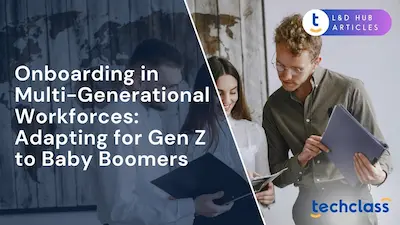
A new employee’s first days and weeks on the job are more than just routine orientation, they set the tone for that person’s future with the company. In fact, a negative onboarding experience can drive talent away quickly; about one-third of new hires leave their job within the first 90 days. On the flip side, getting onboarding right has dramatic benefits, organizations with strong onboarding see new-hire retention improve by up to 82% and productivity boost by over 70%. Yet, despite these clear advantages, only 12% of employees strongly agree their organization does a great job of onboarding, highlighting a major gap and opportunity for improvement.
One effective way to strengthen onboarding is by celebrating milestones throughout the process. Marking small achievements and transitions, from a new hire’s first day, to their first completed week, month, and beyond, provides recognition and reinforces that the employee is valued. This isn’t just a “feel-good” exercise; it’s a strategic approach to employee engagement and retention. When employees feel appreciated and “cared for” as individuals, they are more likely to stay loyal to the organization. By acknowledging onboarding milestones, companies demonstrate support for their new hires’ progress, which can foster stronger emotional connections to the workplace. In short, celebrating milestones during onboarding helps turn new hires into committed, engaged team members from day one.
Employee onboarding isn’t just an HR formality, it’s a critical retention and engagement driver. Recognizing achievements early and often during onboarding has tangible business benefits. Consider that companies with engaging onboarding programs enjoy significantly higher long-term employee retention. By celebrating milestones, you reinforce positive behaviors and progress, which boosts new hires’ confidence and morale. Early recognition shows newcomers that their contributions matter, feeding a sense of purpose from the outset.
Moreover, celebrating onboarding milestones contributes to building a culture of appreciation. New employees who feel welcomed and valued are much more likely to develop an emotional bond with the organization. This emotional connection can make or break their decision to stay. Research published by Harvard Business Review underscores that employees who feel cared for are less likely to leave, feeling genuinely supported outweighs even compensation as a predictor of retention. In other words, an onboarding process that celebrates milestones and personal wins signals that the company cares about its people, not just their output. This perception translates into higher engagement, loyalty, and ultimately better performance.
From a risk perspective, neglecting to acknowledge early milestones can have costly consequences. High turnover in the first year is expensive, replacing an employee can cost an organization up to six to nine months of that employee’s salary in recruiting and training expenses. Simply put, celebratory onboarding practices are an investment. They pay off in the form of improved retention (for example, new hires who had a positive onboarding are 69% more likely to remain with a company for at least three years) and faster ramp-up to full productivity. Especially for leaders like HR professionals and business owners concerned with talent stability, and CISOs or other executives who need employees engaged in vital training (such as security or compliance), the message is clear: celebrating onboarding milestones isn’t just a nice gesture, it’s smart business strategy.
Every organization’s onboarding timeline is a bit different, but there are common milestones in a new hire’s journey that offer perfect opportunities to celebrate progress. Below are some key onboarding stages and how companies can make them special:
Onboarding can begin even before the official start date. The period between offer acceptance and the first day is a critical milestone often called “pre-boarding.” Celebrating this moment can ease a new hire’s anxieties and build excitement for joining the team. For example, you might send a welcome package or personalized note to congratulate them on joining the company. Some organizations mail company swag, a handwritten welcome letter from the CEO or team, or a short video message from future teammates. These gestures make the incoming employee feel valued before they even step foot in the office. It’s also a great time to recognize the milestone of signing on, perhaps a congratulatory email highlighting how happy you are to have them onboard. By acknowledging the new hire’s decision to join, you reaffirm that they made the right choice and set a positive tone.
In practice, effective pre-boarding celebrations can be simple but meaningful. Ensure IT setup and accounts are ready (so the new hire isn’t stuck waiting on day one), and let them know in advance that everything is prepared for their arrival. You could even celebrate the completion of pre-hire requirements, for instance, completing all hiring paperwork or necessary training before day one, by thanking the new hire for tackling those tasks. For roles with mandatory pre-start learning (common in industries like finance or cybersecurity), acknowledging that the new employee finished their pre-joining compliance training shows you appreciate their effort. All these pre-day-one touches collectively celebrate the transition from candidate to employee, making the person feel welcomed into the fold.
The first day on the job is arguably the most important milestone in onboarding. Rather than treating Day One as a dull administrative hurdle, successful companies turn it into a celebration of a new colleague joining the team. Making the first day festive and special helps the employee feel immediately included. For example, some organizations decorate the new hire’s desk with balloons or a welcome sign and encourage team members to stop by and introduce themselves. A team lunch or coffee break on Day One is another popular way to celebrate, it sends the message that the company is truly excited to have this person aboard. Even in a remote setting, managers can kick off Day One with a virtual team welcome call or an e-card signed by the team.
A famous real-world example of first-day celebration comes from Google’s onboarding. New Google employees (“Nooglers”) receive a propeller-topped Noogler hat and join a fun hat ceremony at the end of their orientation week. This quirky tradition is a celebratory ritual that marks the milestone of completing initial orientation. It not only creates a memorable moment for the new hires, but also symbolizes their official welcome into Google’s culture. While not every company will hand out colorful hats, the principle remains: find ways to commemorate the completion of Day One (or week one) in a manner aligned with your culture. It could be presenting a “certificate of first day” achievement, a shout-out in the company’s chat channel praising the new hire’s arrival, or a small branded gift. The goal is to make Day One positive and affirming, so the employee ends the day feeling “Yes, I belong here.”
The end of the first week is another milestone worth celebrating. By this point, the new hire has navigated a flurry of introductions, set up their tools, and gotten a taste of their responsibilities. Recognizing that they’ve successfully made it through week one can boost their confidence. Managers might send a personal “Week One accomplished!” email or note, highlighting a few things the new hire did well in their first days. Some teams gather for a casual Friday wrap-up where they toast the new hire’s first week (even a virtual toast over video chat works). This is also a good time to solicit feedback, asking the new hire how their first week went shows you care about their experience. Framing that check-in as part of the celebration (e.g., “We’re celebrating you finishing your first week! How was it? Let’s make next week even better.”) keeps the tone positive while yielding useful input.
Celebrations at the one-week mark can be small-scale but should involve the team. For example, team members could each share one thing they appreciate about the new hire so far, or one thing they’re excited to tackle together. This reinforces camaraderie and helps the newcomer feel like an accepted part of the group. By acknowledging the first week’s learning curve and effort, you motivate the new employee to dive into week two with even more enthusiasm.
In many organizations, the first 30, 60, and 90 days of employment are important onboarding checkpoints. These markers often coincide with the end of initial training periods, end of probationary windows, or the point at which a new hire is expected to be fully up to speed. Rather than letting these dates pass quietly, leading employers plan 30-60-90 day recognition moments as part of the onboarding journey. For instance, at the one-month mark, a manager might take the new hire out for coffee or lunch to celebrate their first month and discuss how things are going. At 60 days, you might send a company-wide welcome update highlighting the new hire’s contributions so far. And reaching 90 days, essentially the first quarter with the company, can be treated as a mini-anniversary. Some companies present a formal certificate of completion for the onboarding program after 90 days, or give a small reward such as company-branded gear or a gift card as a token of appreciation.
Building a 30-60-90 day recognition plan ensures that new employees receive encouragement throughout their early tenure. Each milestone can have a specific focus. At 30 days, you might celebrate the knowledge they’ve gained (“John has completed all training modules, congrats on a great first month!”). At 60 days, acknowledge integration into the team (“Two months in, John has already contributed to X project, we’re excited to have him on board!”). By 90 days, emphasize their accomplishments and officially welcome them as a fully ramped member of the organization. These structured milestones not only make the employee feel good; they also encourage managers to stay engaged in onboarding. Regular check-in celebrations create a cadence of communication where any concerns can be addressed early, which can prevent a small issue from snowballing into dissatisfaction.
Don’t forget that some role-specific milestones fall in this timeframe as well. For example, in customer-facing roles, the first time a new hire delivers a client presentation or closes a sale is a huge milestone, recognize it. In technical roles, finishing the first solo project or earning a required certification within the first few months deserves celebration too. Even completing all compliance and security training (something CISOs care deeply about) by the 90-day mark is an achievement to acknowledge, perhaps with a shout-out that the new hire is now officially “security certified” within the company. By tying recognition to both time-based and achievement-based milestones, you encourage continuous progress. Each celebration becomes a building block in the employee’s confidence and connection to the company.
While the onboarding process typically tapers off by around 90 days, it’s wise to extend your milestone mindset further out, the six-month and one-year marks are significant moments in an employee’s journey. Reaching six months is often the point at which a new hire is truly hitting their stride and contributing at full capacity. It may also coincide with the end of an official probation period in some organizations. This is a natural time to celebrate the person’s growth since day one. A half-year celebratory check-in could be as simple as a sincere email from a senior leader noting how the employee has grown, or a team celebration of the new hire’s “halfiversary” with the company. Such gestures reinforce that the commitment to the employee’s success didn’t end after onboarding, it’s ongoing.
The one-year anniversary is traditionally a well-recognized milestone (often marked as a “work anniversary”). While it falls slightly beyond most definitions of onboarding, the first anniversary is the capstone of the new hire’s transition into a fully tenured employee. Celebrating this day has special importance: studies show that a positive onboarding experience makes it far more likely employees will stay at least one year and beyond. Companies should absolutely commemorate a first anniversary, whether through a congratulations card signed by the team, a mention in the company newsletter, or even a small award. This celebration not only honors the employee’s contributions over their first year, but it also validates the effectiveness of the onboarding journey they went through. From that point on, milestone celebrations can blend into the regular employee recognition program (such as work anniversaries, promotions, etc.), but the ones during onboarding lay the foundation for a culture of recognition going forward.
To maximize the impact of milestone celebrations, organizations should approach them thoughtfully. Here are some best practices to ensure your onboarding milestone recognition is effective and well-received:
By following these best practices, organizations can avoid the common onboarding pitfall of treating it as a rushed orientation or box-ticking exercise. Instead, onboarding becomes a supportive journey marked by encouragement, validation, and connection. When milestone celebrations are done right, they don’t feel forced, they become eagerly anticipated highlights for new hires. Each celebration, no matter how small, sends a consistent message: “Your growth and contributions matter here.” This message, delivered early and often, builds the foundation for a motivated and engaged employee.
Celebrating milestones during onboarding is more than a series of isolated congratulations, it’s a strategic approach to nurturing your talent from the very beginning. By acknowledging early achievements and important transitions, you show new employees that they are valued members of the organization long before they’ve reached full productivity. This sense of appreciation fuels engagement and loyalty. Remember, the habits and feelings established in the first weeks of a person’s job have a lasting impact. When you weave celebration and recognition into that experience, you’re planting seeds for a positive, committed long-term employee relationship.
For HR professionals and enterprise leaders, the takeaway is clear: design your onboarding process with intentional milestone moments. Whether it’s a welcome note before day one, a team toast at the end of week one, or a 90-day achievement award, these practices require modest effort but yield disproportionately high returns in morale and retention. And for the new hires themselves, milestone celebrations make the challenging process of starting a new job feel encouraging and supportive. It transforms onboarding from a period to “get through” into a journey to enjoy.
Incorporating milestone celebrations into onboarding ultimately builds a culture where wins (big or small) are acknowledged and people feel seen. That culture will not only help retain your newest employees, but will also energize the broader workforce by reinforcing the value of recognition. An employee’s journey with your company may span years, but those critical first stages, when they are finding their footing — deserve careful attention and applause. By making onboarding milestone celebrations a norm, you set the stage for engaged, empowered employees who are excited to grow with your organization for the long haul.
Onboarding milestones are key stages in a new hire’s early journey, such as their first day, first week, or 90-day mark. Celebrating them boosts engagement, morale, and retention by showing employees they are valued from the start.
During pre-boarding, companies can send welcome packages, personalized notes, or team introduction videos. These gestures build excitement, ease anxiety, and affirm the new hire’s decision to join.
Companies can make the first day memorable by decorating the workspace, hosting a welcome lunch, giving a small gift, or organizing a virtual team call. The goal is to make the employee feel included and appreciated.
Recognizing progress at these checkpoints encourages continuous growth, reinforces contributions, and strengthens manager-employee communication. It also helps address concerns early, improving retention.
Remote milestone celebrations can include virtual team calls, digital shout-outs, mailed care packages, or home-delivered treats. The key is ensuring remote employees feel as recognized and valued as in-office staff.


